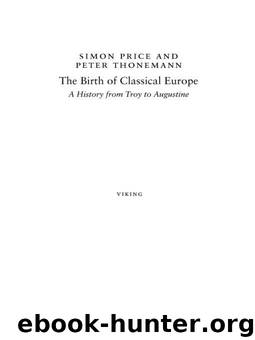The Birth of Classical Europe (The Penguin History of Europe) by Price Simon & Peter Thonemann

Author:Price, Simon & Peter Thonemann [Price, Simon]
Language: eng
Format: azw3
Publisher: Penguin Publishing Group
Published: 2011-01-03T16:00:00+00:00
Map 24. Cosa and its territory. The centuriation is shown by the rectilinear grid north-east of the town.
An important linguistic consequence of the creation of colonies was the spread of Latin. For Cosa, Latin was the native language of the colonists drawn from Rome and Latium, but, equally important, Latin was the official language of all colonies, just as institutions were modelled on those of Rome. Latin was therefore exported to regions of Italy that had previously spoken other Italic dialects, or other languages (Etruscan, Greek, Celtic). In turn, Latin acquired some regional variations as a result of language-learning by people brought up in other dialects or languages, but at Rome there was considerable snobbery about use of rustic Latin and words in Latin borrowed from other Italic dialects or from Etruscan. By the second century BC Latin was the prestige language of the peninsula, and the pressures to adopt it quite widely were considerable. In 180 BC the Greek town of Kymē, which had fallen to Oscan speakers in the fifth century BC, but had received Roman citizenship in 338 BC, asked the Senate for permission to conduct some forms of public business in Latin; the request was granted, but the town could in fact have made the switch without asking the Senate. The local elite must already have been familiar with Latin, but Kymē also remained proud of its Greek past: the prophetic Sibyl was responsible for the oracle of Apollo here, and had been the source for Rome’s Sibylline Books in the regal period.
Some local languages died out, or at least were no longer written down, in the third century BC, but others remained important throughout the second century, disappearing in written form only at the end of the first century BC. In the late second or early first century BC, the town of Bantia (just above the instep of Italy) inscribed its own constitution in Oscan. The type of Oscan employed and some of the civic institutions described were heavily influenced by Latin and by Rome, but the use of Oscan at all in this public context shows a desire to make a statement about Bantian distinctiveness in the face of Roman dominance.
Other expressions of local identities remained important after the Roman conquest. Etruscans continued to maintain their own sense of the past until at least the first century AD. Following defeat in a civil war in 80 BC, some losing Etruscans fled to North Africa, to a remote spot some 50 kilometres south-west of Carthage. The leader of the group, who probably came from Clusium (modern Chiusi), founded a new settlement there, which had boundary stones inscribed in a late north Etruscan script. The startling fact is that the inhabitants were called Dardanii, after Dardanus, the founder of Troy. The settlement was intended to be another Troy; sadly, it vanished almost completely. Some Etruscans, like the Veneti and of course the Romans, were proud of their Trojan origins. In Etruria itself, historical memories were also preserved, despite the dying out of most of the leading families in the first century BC.
Download
This site does not store any files on its server. We only index and link to content provided by other sites. Please contact the content providers to delete copyright contents if any and email us, we'll remove relevant links or contents immediately.
| Africa | Americas |
| Arctic & Antarctica | Asia |
| Australia & Oceania | Europe |
| Middle East | Russia |
| United States | World |
| Ancient Civilizations | Military |
| Historical Study & Educational Resources |
The Daily Stoic by Holiday Ryan & Hanselman Stephen(3263)
The Fate of Rome: Climate, Disease, and the End of an Empire (The Princeton History of the Ancient World) by Kyle Harper(3030)
People of the Earth: An Introduction to World Prehistory by Dr. Brian Fagan & Nadia Durrani(2711)
Ancient Worlds by Michael Scott(2648)
Babylon's Ark by Lawrence Anthony(2646)
The Daily Stoic by Ryan Holiday & Stephen Hanselman(2520)
Foreign Devils on the Silk Road: The Search for the Lost Treasures of Central Asia by Peter Hopkirk(2442)
India's Ancient Past by R.S. Sharma(2432)
MOSES THE EGYPTIAN by Jan Assmann(2393)
The Complete Dead Sea Scrolls in English (7th Edition) (Penguin Classics) by Geza Vermes(2254)
Lost Technologies of Ancient Egypt by Christopher Dunn(2207)
The Earth Chronicles Handbook by Zecharia Sitchin(2202)
24 Hours in Ancient Rome by Philip Matyszak(2064)
Alexander the Great by Philip Freeman(2044)
Aztec by Gary Jennings(1990)
The Nine Waves of Creation by Carl Johan Calleman(1897)
Curse Tablets and Binding Spells from the Ancient World by Gager John G.;(1851)
Before Atlantis by Frank Joseph(1828)
Earthmare: The Lost Book of Wars by Cergat(1806)
